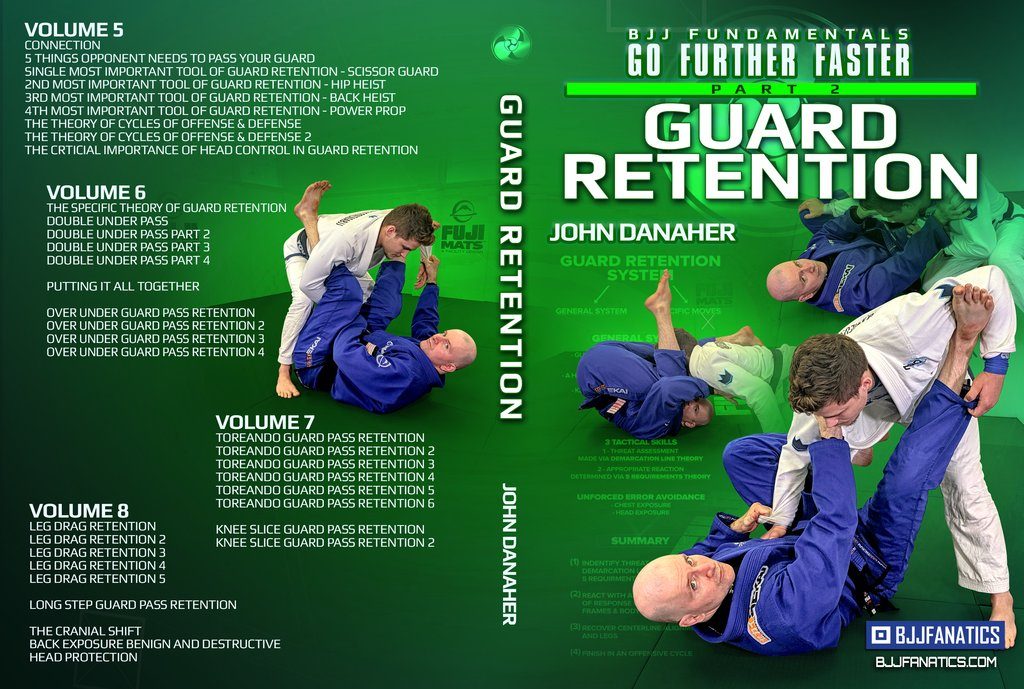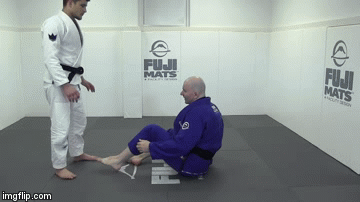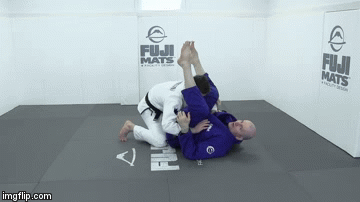
It is just over a year since the first-ever John Danaher DVD instructional came out. As expected it was a No-Gi instructional focusing on leg locks. After that, the flood gates opened and John Danaher hasn’t stopped producing high-level instructions. After completing a 6 part No-Gi series, the enigmatic Renzo Gracie black belt is now focused on uncovering the hidden secrets of Gi Jiu-Jitsu fundamentals. His second volume of the BJJ Fundamentals – Go Further Faster:” series just dropped. It is a Guard Retention instructional and we have the first in-depth Danaher DVD review of it right here!
ON SALE HERE:
John Danaher – Guard Retention (DIGITAL/DVD)

A couple of years ago a Danaher DVD was an unthinkable notion. So much so, in fact, that even getting to a Youtube clip with him sharing just a few words was extremely rare. Well, fast forward to today and we have complete series out. At this moment in time, Danaher is working on his second series, this time on the fundamentals of Gi BJJ. Personally, I am a fan of his work and have seen each and every one of his instructions so far. I’ve also done a Danaher DVD review on all of them as well. Still, it is a great pleasure to pop a brand new Danaher instructional in the player and start learning! This time, the subject is guard retention which is bound to get the attention of even those that are not fans of the New Zealander. IF such grapplers exit, that is.
Danaher’s BJJ Fundamentals – Go Further Faster Series
The one thing I always say to people about the No-Gi Danaher DVD series is that it is not really meant for beginners. Okay, some of the DVD sets, like the one on back control and the front headlock are great for everyone. However, in the leg locks one, or the triangle one, for example, Danaher teaches with the expectation that you have certain fundamentals down. This is exactly why I was really happy to see him do a BJJ fundamentals DVD series. What’s even better is that he is focused on doing one in the Gi!
The “BJJ Fundamentals – Go Further Faster” series is just starting to take a swing. The very first 8 part volume came out a few months ago. As expected, it was a real hit. What this series did is get even those that are not fans of No-Gi Jiu-Jitsu on the Danaher train. The first set was all about escapes, particularly ones that pertain to the turtle position. With that out of the way, the next logical step is what to do after escaping. This is where guard comes in, or, more specifically, guard retention. As you’ll see later on in the in-depth Danaher DVD review, this is a subject that John covers much different than anybody else has so far.
Speaking of guard retention, there’s also the fact that one of Danaher’s star students. Gordon Ryan has an instructional out on guard passing. If you have that one, it is time to put both to the test. Will the student’s guard passing system prevail ver the professor’s guard retention one? I believe we all know the answer to that one. Moreover, the structure of this DVD is somewhat different from previous Danaher releases, making it a truly special BJJ instructional.
Guard Retention: BJJ Fundamentals – Go Further Faster Danaher DVD Review
Although Danaher did change things up among the different DVD sets he put out, he did stick to a certain structure. To that extent, this is once again an 8 part DVD instructional, to begin with. Furthermore, it still has lots of theory and conceptual principles before Danaher even gets to the subject of guard retention. However, this time, there is also a slightly different DVD structure too.
The very first part, for example, covert eh usual introduction. However, instead of doing so in multiple chapters, there are only two. That doesn’t shorten the length of the DVD but rather brings the most important things into focus without any interruptions. Parts 2,3 and four focus on the concepts and key principles behind the guard retention system Danaher has developed. Once again, he demonstrates what not to do, just as much as he shows you what you need to do for successful guard retention. Volume five is all about guard passing, as it pertains to retaining guard in particular. Finally, the remaining three volumes cover different scenarios involving different guard passes. This is a somewhat new approach by Danaher, and it is perfect for the subject he is covering.
From a technical standpoint, our Danaher DVD review did not show any issues with sound, camera work, or the overall designs of the instructional.
An Introduction And The Basic Theories Of Guard Retention
The first part of the Guard Retention BJJ Fundamentals – Go Further Faster DVD series is an introductory one. We know Dahaner likes to speak a lot, giving a detailed overview of his systems before he goes into dissecting them for us. This DVD instructional is no different, as it also starts with an introduction. However, the introduction is much longer than in any previous set. In fact, it takes up about half of the first DVD, which only shows how important it is. Following suit, equally as important as the introduction is the system itself. Danaher goes over all the building blocks of his guard retention system along with a detailed explanation to how they all fit together.
Part two has a somewhat more familiar structure. It has several chapters, each looking int some of the key fundamental aspects of retaining the guard. It starts with the big picture and then heads to some more specific requirements. There’s also a chapter in there that I found really important during this Danaher DVD review – the one on the unforgivable sin of guard retention. Wrapping up is a portion that focuses on the three different postures that make or break any guard retention attempt.
First Skill Of Guard Retention
The one part that took me the most time to get through when doing this John Danaher DVD review was the third one. It is big, yes, containing well over a dozen chapters. However, it also covers arguably the most important aspect of retaining guard – movement. To that extent, Danaher’s retention system is based on three crucial skills. the first of those is movement, and John goes deep into every possible aspect of it in this portion of the instructional.

As the volume progresses, Danaher switches towards the supine movement. This is the portion on which he spends most of his focus in this part. He covers some of the most fundamental BJJ movements lek shrimping and pummeling. However, in his very unique teaching style, he offers a different perspective to each and every one of them. Moreover, a bunch of other movement patterns, from scissoring, through spinning and pendulums all the way to rollbacks also feature heavily here.
Wrapping up are several chapters on the turtle position that include shoulder rolls and sitting up, Of course, he puts everything together at the end to make sense of it all.
Second And Third Skills Of Guard Retention
As I mentioned before Danaher has three skills that are essential to his guard retention system. Movement is the first, and the second and third are framing and braking and negating grips, respectively.
When it comes to framing, we’re all aware of how important it is for any bottom position. From defensive to offensive maneuvers, there’s not much you can do if you don’t have a solid frame. John covers the purpose of framing first and then moves on to cover different types of frames. Apart from the “usual” forearm, forehand, and backhand frames, there’s also the concept of self-framing which is another one of Danaher’s breakthroughs.
AS far as the third and final essential skill is concerned, there’s one long chapter explaining it in details. Grip fighting is an essential skill of BJJ in general. when it comes to guarding retention in the Gi, breaking and negating grips becomes that much more important. Wrapping up is a chapter on demarcation lines which is, arguably, the best portion of the entire instructional!
Understanding Guard Passing
leave it to Danaher to go so deep into the subject of preventing guard passes, that he devotes an entire part of his instructional to understand what the passers’ goals are. here, Danaher starts by covering an aspect of BJJ that is notoriously hard to explain – connection. As expected, he makes it blatantly simple and understandable. that said, he goes on to uncover what every guard passer is looking to achieve. The premise is to know what they want so you can know how to stop it. If there’s anything I learned throughout this Danaher DVD review, it is that knowing what an opponent is after is half the solution to any puzzle in Jiu-Jitsu. Speaking of understanding guard passers, John covers the cycles of offense and defense, showing exactly when you should look to retain your guard.
As the volume progresses, Danaher goes into specifics of guard retention against any pass. This part is the conceptual foundation of Danaher’s guard retention system as a whole. It demonstrates how to use the most important tools of retaining guard in order of importance. Firs tup is the scissor guard, followed by hip and back heisting, and finally the power prop.
Retention In Regard To Specific Guard Passes

Next up is a volume that focuses almost entirely on the Torreando pass. This loose pass is one of the most common ones used in Gi BJJ today. That notwithstanding, it is something that works across all levels of Brazilian Jiu-Jitsu. Danaher offers a total of 6 different scenarios in which he offers ways to prevent the pass at various stages. A couple of knee slice retention examples conclude the 7th volume of the instructional.
The final portion of the Gaurd retention Danaher DVD is all about the leg drag and long step passes. Out of the two, the leg drag gets more attention, with a total of 5 different scenarios covered. The long step gets it’s own chapter too. Wrapping things up is a portion on closing concepts like the cranial shift and head protection.
Conclusion
To be completely honest, I doubt anyone needs an in-depth Danaher DVD review to get his instructionals. However, if I had to choose only one of his BJJ DVD instructionals to get, it would be this one. And yes, that includes the one on leg locks as well. Guard retention is by far one of the most important skills of Jiu-Jitsu and nobody can explain it better than John Danaher. Just pick this DVD up and give it a try!
ON SALE HERE:
John Danaher – Guard Retention (DIGITAL/DVD)



![Darce Choke Encyclopedia – Origins, Mechanics and Variations [2025] BJJ, choke, Brabo, BJJ Darce Choke, D'arce Choke, Darce BJJ Choke](https://bjj-world.com/wp-content/uploads/2017/11/JungPoirierLeeYahoo-218x150.jpg)









![Slicin’ Calves Mikey Musumeci DVD Review [2025] Slicin' Calves Mikey Musumeci DVD Review](https://bjj-world.com/wp-content/uploads/2025/04/slicin-calves-mikey-musumeci-dvd-review-218x150.png)
![Jiu-Jitsu For Old Guys Guard Retention Bernardo Faria DVD Review [2025] Jiu-Jitsu For Old Guys Guard Retention Bernardo Faria DVD Review](https://bjj-world.com/wp-content/uploads/2025/03/old-guys-guard-retention-bernardo-faria-dvd-review-218x150.png)
![X-Guard Trickery Kyle Sleeman DVD Review [2025] X-Guard Trickery Kyle Sleeman DVD Review](https://bjj-world.com/wp-content/uploads/2025/03/x-guard-trickery-kyle-sleeman-dvd-review-218x150.png)
![Countering with Crab Ride Anthony Budion DVD Review [2025] Countering with Crab Ride Anthony Budion DVD Review](https://bjj-world.com/wp-content/uploads/2025/03/countering-with-crab-ride-anthony-budion-dvd-review-218x150.png)
![Closet Closed Guard Craig Jones DVD Review [2025] Closet Closed Guard Craig Jones DVD Review](https://bjj-world.com/wp-content/uploads/2025/03/closet-closed-guard-craig-jones-dvd-review-218x150.png)
![Xanadu Back Takes Levi Jones-Leary DVD Review [2025] Xanadu Back Takes Levi Jones-Leary DVD Review](https://bjj-world.com/wp-content/uploads/2025/03/xanadu-back-takes-levi-jones-leary-dvd-review-218x150.png)





![Best Marcelo Garcia Techniques by Team Marcelo Garcia DVD Review [2025] Best Marcelo Garcia Techniques by Team Marcelo Garcia DVD Review](https://bjj-world.com/wp-content/uploads/2025/02/best-marcelo-garcia-techniques-dvd-review-100x70.png)
![X-Guard Trickery Kyle Sleeman DVD Review [2025] X-Guard Trickery Kyle Sleeman DVD Review](https://bjj-world.com/wp-content/uploads/2025/03/x-guard-trickery-kyle-sleeman-dvd-review-100x70.png)
![Zen Guide To Submission Grappling Margot Ciccarelli DVD Review [2025] Zen Guide To Submission Grappling Margot Ciccarelli DVD Review](https://bjj-world.com/wp-content/uploads/2025/02/submission-grappling-margot-ciccarelli-dvd-preview-100x70.png)



![No-Gi Pressure Mastery JT Torres DVD Review [2024] No-Gi Pressure Mastery JT Torres DVD Review](https://bjj-world.com/wp-content/uploads/2024/10/no-gi-pressure-mastery-jt-torres-dvd-review-100x70.png)



![Understanding The Distance On Top Gui Mendes DVD Review [2024] Understanding The Distance On Top Gui Mendes DVD Review](https://bjj-world.com/wp-content/uploads/2024/10/distance-on-top-gui-mendes-dvd-review-100x70.png)
![Closed Guard Reintroduced Adam Wardzinski DVD Review [2025] Closed Guard Reintroduced Adam Wardzinski DVD Review](https://bjj-world.com/wp-content/uploads/2025/01/closed-guard-reintroduced-adam-wardzinski-dvd-review-100x70.png)
![Dynamic De La Riva Guard Otavio Sousa DVD Review [2025] Dynamic De La Riva Guard Otavio Sousa DVD Review](https://bjj-world.com/wp-content/uploads/2025/02/dynamic-de-la-riva-guard-otavio-sousa-dvd-review-100x70.png)





![Position And Submission Escapes Craig Funk DVD Review [2025] Position And Submission Escapes Craig Funk DVD Review](https://bjj-world.com/wp-content/uploads/2025/02/position-and-submission-escapes-craig-funk-dvd-review-100x70.png)

![How To Knee Cut Junny Ocasio BJJ DVD Review [2025] How To Knee Cut Junny Ocasio BJJ DVD Review](https://bjj-world.com/wp-content/uploads/2025/02/how-to-knee-cut-junny-ocasio-bjj-dvd-review-100x70.png)
![Compass Kneebar System Charles Harriott DVD Review [2024] Compass Kneebar System Charles Harriott DVD Review](https://bjj-world.com/wp-content/uploads/2024/11/compass-kneebar-system-charles-harriott-dvd-review-100x70.png)

